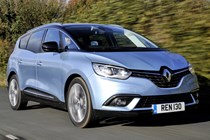
Renault Grand Scenic Estate (2016-2020) engines, drive and performance
.jpg)
- Trio of diesels expected to sell well
- Petrol engines feel gutless for car of this size
- Unusual hybrid has a manual gearbox
At launch, a choice of six engines is offered, all with a six-speed manual gearbox as standard with a twin-clutch automatic available on the least- and most-powerful diesels.
Duo of petrol choices
- TCe 115 – 1.0-litre, 115hp, 190Nm turbo petrol, six-speed manual. 0-62mph in 13.0 seconds, max speed 114mph, 46.3mpg, 136g/km CO2
- TCe 130 – 1.2-litre, 130hp, 205Nm turbo petrol, six-speed manual. 0-62mph in 11.9 seconds, max speed 117mph, 46.3mpg, 136g/km CO2
The turbocharged petrol engines are both reasonably refined but do need working hard to heft this seven-seater around. They are eager to rev, but even so, performance figures are hard to match in the real world.
Three diesels expected to be more popular
- dCi 110 – 1.5-litre, 110hp, 260Nm turbodiesel, six-speed manual or dual clutch auto. 0-62mph in 12.4 seconds, max speed 114mph, 70.6mpg, 104g/km CO2
- dCi 130 – 1.6-litre, 130hp, 320Nm turbodiesel, six-speed manual. 0-62mph in 11.4 seconds, max speed 118mph, 61.4mpg, 119g/km CO2
- dCi 160 – 1.6-litre, 160hp, 380Nm turbodiesel, dual-clutch auto. 0-62mph in 10.7 seconds, max speed 124mph, 60.1mpg, 122g/km CO2
Mated to a smooth twin-clutch automatic transmission, the 160hp turbodiesel feels a better fit for three reasons: firstly, it offers better low-down torque for greater urgency off the line and during overtaking, secondly, the Grand Scenic’s family oriented design lends itself ideally to an automatic gearbox and, thirdly, the diesel doesn’t have to try so hard to maintain a high-speed cruise, and is therefore often inaudible beneath that door mirror wind noise.
Unusual diesel-electric hybrid
- dCi 110 Hybrid Assist – 1.5-litre, 110hp, 260Nm Hybrid Assist turbodiesel with 10kW electric motor, six-speed manual. 0-62mph n/a, max speed n/a, 80.7mpg, 92g/km CO2
Hybrid Assist is an affordable way for Renault to enter the part-electrically-powered arena. Rather than building the electric motor into the gearbox, it takes the place of the alternator alongside the engine, and takes power from an 11kg lithium-ion battery pack under the boot floor.
Tax-significant 8-10 percent reduction in fuel consumption and CO2 emissions aside, Renault quotes identical performance figures for this unit and the standard 110hp turbodiesel, suggesting the extra 44kg weight of hybrid componentry balances out any performance advantage. A brief drive does however suggest it adds sprightliness in the urban environment, thanks to an electric motor’s ability to generate maximum torque from zero revs.
- Difficult to position the car at low speeds
- Works best when cruising in a relaxed manner
- Not as fun to drive as its Ford rival
When parking or during other low-speed manoeuvres, the shape of the windscreen pillars can make it difficult to locate the front corners of the car, causing us to wince in fear of kerbing one of those large alloy wheels. It also pushes the windscreen so far forwards that the dash top feels like acres of wasted space; perhaps it should be fully glazed-in and serve as a tropical fish tank.
On the open road, Renault’s dual-clutch EDC automatic gearbox is a far better fit to the Grand Scenic’s driving characteristics than a manual transmission; mated to the dCi 160 diesel it offers smooth, torque-laden progress with plenty of overtaking go. The light steering, meanwhile, is precise and accurate enough without offering over-much communication.
Despite wider front and rear tracks than those of the previous model there’s still quite a deal of body roll through corners. In order to keep the rubber cladding those handsome 20-inch alloys affordable and not too detrimental to fuel consumption, the tyres are narrower than their diameter would suggest, with inevitable implications for grip levels.
Easy to drive at loafing speeds, then, but don’t try and keep up with Ford’s Grand C-Max when things get twisty.



.jpg)
.jpg)
.jpg)
.jpg)
.jpg)
.jpg)
.jpg)
.jpg)
.jpg)
.jpg)
.jpg)
.jpg)
.jpg)
.jpg)
.jpg)
.jpg)
.jpg)
.jpg)
.jpg)
.jpg)
.jpg)
.jpg)
.jpg)
.jpg)
.jpg)
.jpg)
.jpg)
.jpg)
.jpg)
.jpg)
.jpg)
.jpg)
.jpg)
.jpg)
.jpg)
.jpg)
.jpg)
.jpg)
.jpg)
.jpg)

.jpg?quality=50)
.jpg?quality=50)
.jpg?quality=50)
.jpg?quality=50)
.jpg?quality=50)
.jpg?quality=50)
.jpg?quality=50)
.jpg?quality=50)
.jpg?quality=50)
.jpg?quality=50)
.jpg?quality=50)
.jpg?quality=50)
.jpg?quality=50)
.jpg?quality=50)
.jpg?quality=50)
.jpg?quality=50)
.jpg?quality=50)
.jpg?quality=50)
.jpg?quality=50)
.jpg?quality=50)
.jpg?quality=50)
.jpg?quality=50)
.jpg?quality=50)
.jpg?quality=50)
.jpg?quality=50)
.jpg?quality=50)
.jpg?quality=50)
.jpg?quality=50)
.jpg?quality=50)
.jpg?quality=50)
.jpg?quality=50)
.jpg?quality=50)
.jpg?quality=50)
.jpg?quality=50)
.jpg?quality=50)
.jpg?quality=50)
.jpg?quality=50)
.jpg?quality=50)
.jpg?quality=50)
.jpg?quality=50)